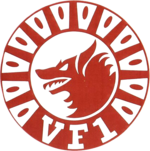VF-1
| Fighter Squadron 1 | |
|---|---|

VF-1 insignia
|
|
| Active | 14 October 1972 - 1 October 1993 |
| Country | United States |
| Branch | United States Navy |
| Type | Fighter |
| Role |
Air interdiction Aerial reconnaissance Close air support |
| Garrison/HQ | NAS Miramar |
| Nickname(s) | "Wolfpack" |
| Engagements |
Vietnam War * Operation Frequent Wind Operation Desert Storm |
| Aircraft flown | |
| Fighter | F-14 Tomcat |
Fighter Squadron 1 (VF-1) was a fighter squadron of the United States Navy. Originally established on 14 October 1972 it was disestablished on 30 September 1993. It was the 5th US Navy squadron to be designated VF-1. Known as the "Wolfpack" the squadron saw combat during the Vietnam War and Operation Desert Storm. The squadron was de-activated and its personnel reassigned in 1993 when its carrier, the USS Ranger (CV-61), was decommissioned.
VF-1, Wolfpack was established on 14 October 1972 at NAS Miramar, at the same time as VF-2, these units were the first operational fighter squadrons equipped with the Grumman F-14 Tomcat. VF-1 received the first F-14As on 1 July 1973. The squadron's insignia was a red wolf’s head designed by Grumman Commercial Artist, George M. Kehew who himself is a WWII combat veteran. The squadron insignia is registered in the U.S. Library of Congress.
VF-1 was assigned to Carrier Air Wing 14 (CVW-14) aboard USS Enterprise (CVAN-65). The first cruise came in September 1974. The end of the cruise saw the first Tomcat’s combat debut, as VF-1 and VF-2 flew cover over Saigon for evacuation of US personnel in April 1975 as part of Operation Frequent Wind.
In July 1976, Enterprise began her eighth Western Pacific deployment. In February 1977, Idi Amin, the President of Uganda, made derogatory remarks against the United States in public and Americans in Uganda were taken hostage. This was several months after the Israeli raid at Entebbe airport. Enterprise and her escort ships were scheduled to transit home after a seven-month deployment, but having just left Mombasa after a port call, were directed to remain in the area and operated off the east African coast for about one week. The ship's Marine detachment and air wing prepared for a possible mission to rescue and evacuate the Americans, but Amin eventually released all the hostages. The ships then steamed across the Indian Ocean at high speed to make a previously scheduled final port call at NAS Cubi Point in the Philippines before returning to NAS Alameda.
...
Wikipedia
